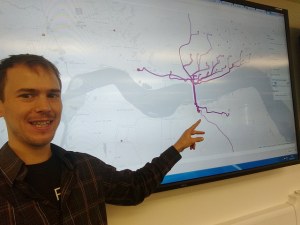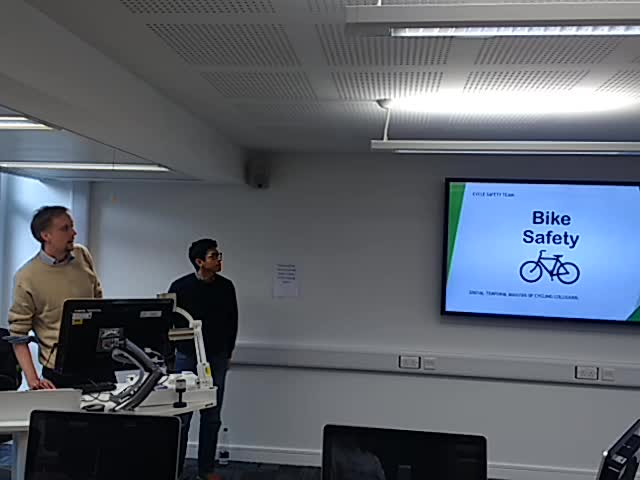Interested in using data for Social Sciences research? We are currently looking to fund up to twelve projects (£25-50K) across an extensive range of disciplines and research areas – Find out more.
“Young people need to vote. They need to get out there. Every vote counts. Educate yourself too. Don’t just vote. Know what you’re voting for, and stand by that.” Nikki Reed, American Actress
One of the oft cited phenomena from the recent 2017 United Kingdom General election has been the rise in the participation by the young in the electoral process. Factors that point to this are an increase in voter registration by the young, greater turnout to vote by the young and an increase in the Labour vote share – since the young have a tendency to vote Labour. This piece addresses the first of these issues, the increase in voter registration and examines whether this can be tied to specific features of the population.
National Picture
Information on the number of registered voters is published at General elections and annually, in December. Those eligible to register to vote in UK General elections are those who are 18 years of age or over on polling day, who are a British, Irish or qualifying Commonwealth citizen and they must be resident at an address in the UK (or a UK citizen living abroad who has been registered to vote in the UK in the last 15 years). EU nationals (that are not Irish or Commonwealth citizens) are not eligible to vote, nor are members of the House of Lords or prisoners.
The summary counts for the number of registered voters in Westminster Parliamentary elections is given here:
| Country |
5th May 2015 (GE)[1] |
1st December 2015[2] |
1st December 20162 |
8th June 2017 (GE)[3] |
Increase
GE to GE |
Growth index |
| England |
38,736,146 |
37,399,942 |
38,386,864 |
39,297,181 |
561,035 |
(101.4) |
| Wales |
2,281,754 |
2,181,841 |
2,243,919 |
2,298,161 |
16,407 |
(100.7) |
| Scotland |
4,099,532 |
3,896,852 |
3,929,963 |
3,988,441 |
-111,091 |
(97.3) |
| Northern Ireland |
1,236,765 |
1,243,369 |
1,205,683 |
1,242,698 |
5,933 |
(100.5) |
| Total |
46,354,197 |
44,722,004 |
45,766,429 |
46,826,481 |
472,284 |
(101.0) |
These figures show that following the General election on the 5th May 2015 the size of the electoral register shrunk considerably when counted later that same year. The prospect of no General election for another five years may have provided no motivation for people to maintain their registration. A year later in December 2016, the size had increased (thanks to the intervening European Union membership referendum held on the 23rd June 2016), but it did not recover to the levels seen on the 5th May the previous year. By the time of the recent General election however the size of the register had increased, only modestly, by just 1.0%. But this story of modest increases is not uniform across the UK.
The strongest growth was seen in England with a 1.4% increase whilst in Scotland there was an actual decrease of 2.7%. Ideally, these growths should be put in the context of growth in the national population aged 18 and older, however this would require access to population counts that only covered those eligible to vote, most specifically one that excluded many EU nationals. These counts are not readily available.
Local Picture
These national patterns are apparent when seen on a map. Here the index of growth or decline is shown as a geographic map of Westminster Parliamentary constituencies (WPCs) and as a cartogram. The warmer colours, yellow, orange and red signify an increase in the electorate, whilst the cooler colours of green and blue signify a decrease. These maps clearly identify the differences in the growth within the UK, with only a few WPCs in Scotland showing a growth.
The explanation for this in Scotland might be due to their recent Independence referendum. In Scotland the 2015 General election was run very soon after the 18th September 2014 Independence referendum. The referendum generated a great deal of interest in voting which would have contributed to a subsequent high registration for the 2015 General election. This high level of registration was not maintained to the 2017 General election, causing the apparent decline. Otherwise, hot spots of growth are apparent in Northern England and the South West of England.
Detailed Picture
Thoughts then turn to ask if these local increases in voter registration can be explained by something about the nature of the WPC. Specifically there has been talk in the media that this has been driven by variously: the number of young people in the WPC (aged 18 to 24); the number of students; or the number of young graduates[4]. All these potential factors are characterised by the youth of the population of interest. Unfortunately at registration, no information on the age of the individual is captured (unless they are due to ‘attain’ the age of 18 within the year) so directly investigating these suppositions is impossible. Nevertheless, in what follows, tables and simple scatter diagrams are used to try and tease out any such relationships using secondary data. Firstly population counts are used. However, recent estimates of the population in each WPC, by single year of age, are not consistently available. Here estimates for the 2015 population are used in England and Wales, estimates from 2014 are used in Scotland and estimates from the 2016 used in Northern Ireland. Secondly, the more detailed 2011 census counts are used to provide information on the number of students in each WPC and also the number of highly qualified young graduates in each WPC.
The top 20
The table below list the 20 WPCs with the largest growths in electorate along with these characteristics. Surprisingly the WPC with the largest growth is not a WPC that could be characterised as young or student focused – it is relative new, having been created in 2010 and has returned a Conservative MP with a comfortable majority at all elections. The following five WPCs do however have a predominantly young, well-educated and student population, helping to substantiate the ideas that it is such populations that positively influenced registration. Elsewhere in the top 10, Sheffield Central stands out as another WPC where registrations might have been driven by young students (but notice that the ‘stellar’ proportions seen here for this WPC did not feed through to a ‘stellar’ growth in registrations). So looking at this, the evidence is quite mixed as to whether a young, informed and educated population is driving the increased registration.
| Name |
Growth
GE to GE |
Aged 18 to 24 |
Students |
Aged 16 to 24 Graduates |
| Bridgwater and West Somerset |
1.109 |
7% |
6% |
1% |
| Leeds North West |
1.100 |
25% |
29% |
5% |
| Leeds Central |
1.095 |
24% |
25% |
5% |
| Lancaster and Fleetwood |
1.084 |
19% |
22% |
3% |
| Colchester |
1.078 |
12% |
12% |
2% |
| Liverpool, Riverside |
1.078 |
27% |
31% |
5% |
| East Devon |
1.076 |
7% |
6% |
1% |
| Sittingbourne and Sheppey |
1.075 |
8% |
6% |
1% |
| Sheffield Central |
1.072 |
32% |
38% |
7% |
| Rochester and Strood |
1.072 |
10% |
8% |
2% |
| Mid Bedfordshire |
1.072 |
7% |
8% |
2% |
| Hyndburn |
1.070 |
8% |
7% |
1% |
| Lewisham, Deptford |
1.069 |
10% |
15% |
4% |
| Wellingborough |
1.066 |
7% |
6% |
1% |
| Bradford West |
1.066 |
13% |
17% |
3% |
| Bradford East |
1.065 |
9% |
10% |
2% |
| Bradford South |
1.064 |
8% |
8% |
1% |
| Poplar and Limehouse |
1.064 |
10% |
13% |
6% |
| Crewe and Nantwich |
1.064 |
9% |
9% |
2% |
| Chatham and Aylesford |
1.061 |
9% |
7% |
1% |
More broadly …
Looking outside this top 20 for further support shows that the picture is far from clear. The first scatter plot below is those who are aged 18 to 24, as a share of the population, on the x axis and the growth/decline in registration on the y-axis.

This plot is characterised by a dense ‘ball’ of observations with a scattering of observations to the right. Other than this, there appears to be little structure to this figure to help us understand how the youthfulness of a WPC influences the growth or decline in registrations.


Scatter plots of the proportionate size of the student population and the younger graduate population shows a similar lack of overall structure (note here that a level 4 qualification includes degrees and professional and higher vocational qualifications).
Educated guesses
In trying to understand the variation in voter registration between the two most recent General elections there is clearly a broad geographic pattern, with the Scottish WPCs showing a distinct decline in registrations, Northern Ireland a slight increase and a mixed pattern in England and Wales.
Differences explainable by issues such as history or demography are harder to find. Undoubtedly there are instances of WPCs where it is reasonable to assume that the increase in voter registration is driven by the specific characteristics of the WPCs, particularly in regards to the relative youth of a population. This is evident in the second table of WPCs, growths and population shares. However, this cannot be the complete picture. In the same table, and more widely in the scatter plots, there are instances of WPCs with high growths in turnout that are not youthful. There are also very youthful WPCs where the growth in registration is no way as high as would be expected. So, whilst the youthful population contributed in some WPCs, there are other WPCs where its impact was not felt and still others where the growth in registration came from other factors.
In terms of electoral impact, the registration is just the first stage, voters need to turn up to vote and to cast their vote for their party[5]. There is undoubtedly scope for an examination of the youth vote on turnout and party affiliations.
About the author
Stephen Clark works as a Research Fellow in the Consumer Data Research Data, based at Leeds Institute for Data Analytics. He has worked in the academic, public and private sector, mainly in the field of transport planning. After gaining his PhD in health forecasting he has worked on a variety of projects including: demographic modelling, utilities demand forecasting, consumer data research and understanding political sentiment.
Feature image by secretlondon123 from the Londonist Flickr pool.
[1] General Election 2015 http://researchbriefings.parliament.uk/ResearchBriefing/Summary/CBP-7186
[2] Electoral Statistics for the UK https://www.ons.gov.uk/peoplepopulationandcommunity/elections/electoralregistration/datasets/electoralstatisticsforuk
[3] General Election 2017 : results and analysis http://researchbriefings.parliament.uk/ResearchBriefing/Summary/CBP-7979
[4] Voter registration soars among students with 55% backing Labour https://www.theguardian.com/politics/2017/may/04/voter-registration-soars-students-backing-labour-corbyn-general-election
[5] ‘Youthquake’ behind Labour election surge divides generations https://www.theguardian.com/politics/2017/jun/20/youthquake-behind-labour-election-surge-divides-generations












